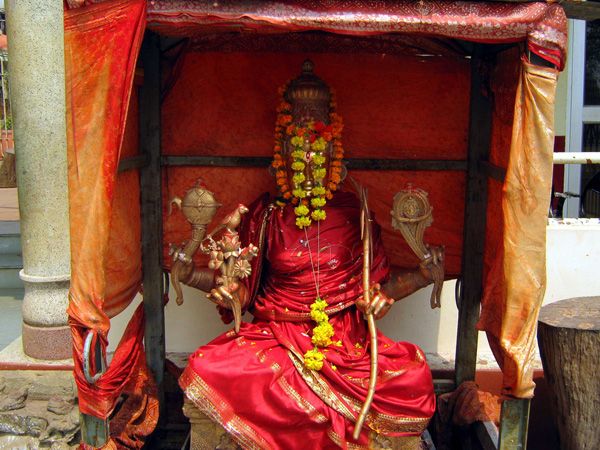
Goddess Kamakhya Devi ( Image via Flickr)
The temples of goddess Kamakhya in Guwahati and Goddess Parvati at the Chengannur Mahadeva Temple in Kerala remain closed for three days at specific times of the year, unlike most other temples. These menstruating idols of India are said to bleed red during that period, thus prompting the temple authorities to cut off access to the goddess, much like we ordinary mortal women too are kept away in seclusion.
We Indian women are no strangers to menstrual taboos. Seclusion for three days, no touching others, no touching pickles, separate clothes, crockery, rooms, we know it all. Many of us still undergo it on a daily basis.
But you would think that, given the reverence and the exalted position gods and goddesses hold in our daily lives, festivals and rituals, that these celestial beings would be spared the earthbound burden of menstrual taboos. But it’s only gods who are above it all. Goddesses at the end of the day are women and therefore subject to the same kind of discrimination.
At the Chengannur Mahadeva Temple in Kerala, Goddess Parvati menstruates and it is the duty of the head priest to watch out for blood stains on her clothing every morning. Parvati and her husband Shiva are the presiding goddess and god of the temple, but during those three days of menstruation, she is taken out of the inner sanctum, much like we women are not allowed in there during our days of menstruation.
At the Chengannur Temple, Kerala
When a ‘blood stain’ is seen, the wife of the Supreme Priest of Sabarimala is called upon to confirm if the Devi is indeed menstruating. If yes, then Parvati’s idol is shifted into a small room off the sanctum sanctorum and the temple remains closed for four days.
The goddess is left alone for these three days, except for a couple of women related to the priests who sleep outside the chamber where she is kept. On the afternoon of the third day, some women visit her, dress her in old clothes (just as we would when we are having our period) and prepare her for the ritual river dipping and ceremony on the fourth day. Surprisingly enough the bloodied menstrual cloth of the goddess is auctioned off each time and fetches a very high price.
Similarly, the Ambubachi Mela is held every year in Guwahati for the Goddess Kamakhya in the month of aashad when the goddess is supposed to bleed. Even here, during those three days, the temple remains closed while the nearby Brahmaputra river leeches red. The holy water is distributed on the fourth day.
Goddess Kamakhya Devi
Advocate Unnikrishnan Nair, a temple historian in Kerala spoke to the News Minute about the Parvati temple in this regard. “Since a girl attaining puberty is a moment to celebrate, that became the most important ritual of the temple,” he said. “Like any other temple women can’t enter this one during their menstruation. During the menstruation time, Devi will be shifted to a different room.”
Now, there is likely a scientific explanation for the idols leeching red colour, but it is sheer irony that even the goddess is not allowed during her menstrual cycle into these temples, which celebrate menstruation. What’s more, women devotees observe the same taboos of not entering these temples too during their menstruation. What are we celebrating then?
More on>> Balancing Act




